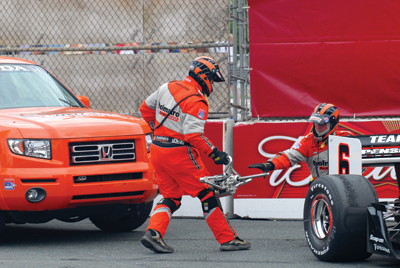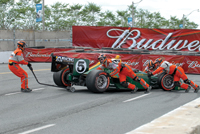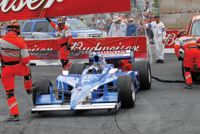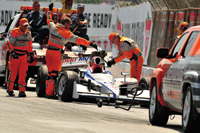
Features
Health and wellness
Hot topics
Safety first
As a firefighter and racing fan, I have had the opportunity to meet with professional racing safety teams from IMSA and Mosport. This summer, I met the only other safety team dedicated to a series in North America: the Indy Racing League Holmatro Safety Team.
October 14, 2010
By Keith Hamilton
As a firefighter and racing fan, I have had the opportunity to meet with professional racing safety teams from IMSA and Mosport. This summer, I met the only other safety team dedicated to a series in North America: the Indy Racing League Holmatro Safety Team.
For more than 20 years, the hydraulic rescue tools I’ve used have had the familiar orange colours of Holmatro Rescue tools. Those colours adorn a tractor trailer that travels from Indianapolis across North America, Brazil and Japan. The Indy Racing League is the only open wheel racing series whose dedicated safety team travels to every racing venue providing fire, rescue and medical care for their drivers and team members. This relationship allows the safety team and IndyCar management to practise and train together and to plan for the future. The research and development department at Holmatro can test its rescue tools on the proposed chassis components of future designs to ensure the team is prepared for an emergency.

|
| A Holmatro Safety Team member passes the engine starter so driver Ryan Briscoe can rejoin the race. Photo by Keith Hamilton |
I talked to Mike Yates, manager of track safety operations for the IndyCar series’ Holmatro Safety Team in July at the Honda Indy in Toronto. He is a veteran of the fire service and the racing safety team. The Holmatro Safety Team was created specifically to look after the IndyCar and Indy Lights racing series. The two cars are similar in terms of safety; the major difference is that the Indy Lights cars have starters, and if they spin but don’t crash, they can restart on their own. The rescue truck will still be there in case of other problems or if a restart isn’t possible. Indy-type cars do not have starters, and the Holmatro rescue trucks are equipped with the same starters the race teams use to restart a car – if it is safe to do so. Of course, if the four tires are still on a race car, most racers want the safety team to restart them, but if a suspension component has been compromised, the safety team will not restart the car and the race is over for that driver.
The Holmatro safety team consists of 25 members; 15 of them attend each race. The safety team brings three trucks to every race and staffs them with four rescue members each. Two other members work as medics in the pit area, and one member works as a dispatcher and fire controller. Every member is a firefighter/paramedic; the majority are from Indiana, with two members from Florida and one from Phoenix. Most of the 17 IndyCar races are in North America but the team travels internationally with stops in Japan and Brazil during the racing year.
The safety team equipment is taken to each venue on a tractor trailer designed to transport race cars. The three safety trucks are carried above, and all the safety equipment and personal items are carried below, in either the cabinets on the lower level or in storage compartments below floor level. The rescue trucks are kept on a moveable floor that is lowered when the trucks are on board and then raised after the trucks are removed at a venue. The space below is then used by the safety teams as a quiet place to relax or get ready for the day’s events. When travelling to Japan or Brazil, all the rescue equipment travels on two 747 jets, loaded on board with the race cars.
 |
|
| Driver Takuma Sato’s race is over and the Holmatro safety team rushes to move him out of danger at the end of the Lakeshore Boulevard straight in Toronto. Photo by Keith Hamilton |
Honda supplies Ridgeline trucks for the safety team. Two of the trucks are set up as rescue trucks, with Holmatro tools and two portable power units to operate them.
Holmatro spreaders and cutters are the standard tools with a special pedal cutter added in case of need. The trucks also carry 60 gallons of water mixed with Cold Fire (foam fire suppressant) routed through a front-bumper mounted, 30-foot forestry-type hose. Pressurized water cans are also carried premixed with Cold Fire foam.
The rescue trucks also provide emergency medical treatment and carry an assortment of airway and advanced life support equipment for the responding paramedics to use. In most cases, local EMS/paramedics handle advanced life support, but the team is cleared to perform certain procedures depending on the venue.
Driver stabilization equipment is carried and techniques and equipment are practised two or three times a year. If, during the year, any changes are made to the racing cars, the technical people contact the safety team and training is conducted to ensure the changes won’t affect the way rescuers approach a car when a driver has to be rescued. Up to eight hours of training is provided to the local fire, safety and EMS personnel when the team arrives at each race location.

|
|
| Canadian driver Paul Tracy spins in corner three during the race and stalls his car. The Holmatro Safety Team uses its starter to restart his engine so he can complete the race. Photo by Keith Hamilton |
The speed of the cars on the track can be hazardous to the safety crews. The cars do not pit during accidents but are on the track with the safety teams. Drivers are aware of the safety teams and pay attention to directions, but things can be a little violent on race day. Safety team members must stay on edge and never let their guard down or turn their backs to traffic.
Radio communication with the dispatcher is also important to ensure the safety team knows where the race pack is located on the track and whether there is a single car trying to catch the pack, so the rescuers can stand and watch out. It is important that safety team members do not make any movements before they look around to make sure they can move safely.
An actual rescue on the track – and the safety precautions that go with it – is not much different than rescues performed by firefighters every day. The only real difference is the safety team’s level of familiarity with the race cars, compared to the myriad makes and models that firefighters deal with daily. Trauma treatment of the drivers is basically the same as on the street – follow the ABCs of airway, breathing and circulation, and immobilize for broken bones or spinal cord injuries. The biggest difference is the environment in which these actions are performed.
The position of safety team members in the truck determines their tasks at the scene. The driver is the incident commander; responsible for size up and calling in resources. The front passenger is the paramedic; he is responsible for the medical needs of the driver. The seat behind the passenger is for firefighter No. 1, whose task is to take the pressurized water can with Cold Fire to the scene and look for fire. Firefighter No. 2 sits behind the driver and is to bring a five-gallon pail of oil dry to contain any spills to the area around the race car.
 |
|
| Hideki Mutoh’s car is prepared for removal from the track after crashing in corner two during practice. Photo by Keith Hamilton |
If the driver is uninjured, he can get out on his own and be transported by ambulance or by the IRL doctor car. If the driver is injured, firefighter No. 2 drops his oil dry responsibility, and gets up onto the engine cowl to take over spinal immobilization so the paramedic can work and get a cervical collar on the driver after the helmet is removed. Firefighter No. 2 can fill in for firefighter No. 2 at that point, or join with the team leader at the driver’s shoulders to help with driver removal. It’s a very methodical approach that is practised during training sessions. It becomes second nature to know what to grab and what to do when arriving at an incident.
Indy cars use alcohol as a fuel so the rescue teams respond with water and Cold Fire to combat fires. Water mixes with the alcohol and the Cold Fire additive can be easily turned into foam by putting a thumb over the nozzle to create a fine spray. Dry chemical extinguishers aren’t used because of the proximity to the drivers and their confined space in the cockpit. Dry chemical can cause respiratory irritation and are harmful to the aluminium parts on the race car, including the engine.
Rescue teams are also responsible for the race track. Fluids or debris that get onto the track from an accident can create further danger to other racers. The rescue team helps to clean and remove debris and fluids from the racing surface to prevent putting the other racers in danger. The rescue trucks carry kits to allow the Indy race cars to be picked up by tow trucks. They also have “diapers” to keep fluids from dropping onto the track.
Holmatro has supplied rescue equipment for the Indy Racing League since it began in 1996. This year, Holmatro, after being an important resource for the IZOD IndyCar Series and Firestone Indy Lights, took over as sponsor of the Racing League Safety Team.
Keith Hamilton is a captain on a rescue squad with Toronto Fire Services. He has 32 years of service with 22 years on the squad. Being a photographer and avid race fan gives him the opportunity to be close to the action and see how various racing series’ safety teams function. Contact him at rescues313@bell.net
Print this page